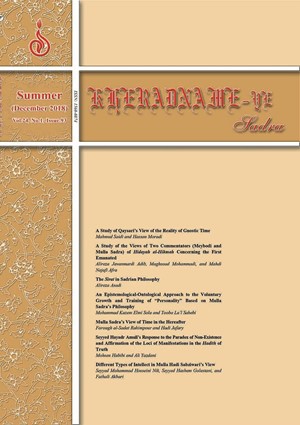-
-
List of Articles
-
Open Access Article
1 - Mulla Sadra’s View of Time in the Hereafter
Hadi Jafary Furugh al-Sadat Rahimpoor -
Open Access Article
2 - An Epistemological-Ontological Approach to the Voluntary Growth and Training of “Personality” Based on Mulla Sadra’s Philosophy
Tooba La’l Sahebi Mohammad Kazem Elmi Soola -
Open Access Article
3 - A Study of Qaysari’s View of the Reality of Gnostic Time
Hassan Moradi mahmoud saidi -
Open Access Article
4 - The Sirat in Sadrian Philosophy
Aireza Asadi -
Open Access Article
5 - Foreword
Seyyed Mohammad Khamenei -
Open Access Article
6 - A Study of the Views of Two Commentators (Meybodi and Mulla Sadra) of Hidayah al-Hikmah Concerning the First Emanated
Maqsud Mohammadi Mehdi Najafiafra -
Open Access Article
7 - Seyyed Hayadr Amuli’s Response to the Paradox of Non-Existence and Affirmation of the Loci of Manifestations in the Hadith of Truth
Mohsen Habibi Ali Yazdani -
Open Access Article
8 - Different Types of Intellect in Mulla Hadi Sabziwari’s View
Seyyed Mohammad Hosseini Nik Seyyed Hashem Golestani Fathali Akbari
-
The rights to this website are owned by the Raimag Press Management System.
Copyright © 2017-2026







